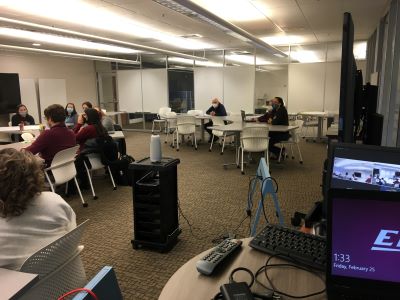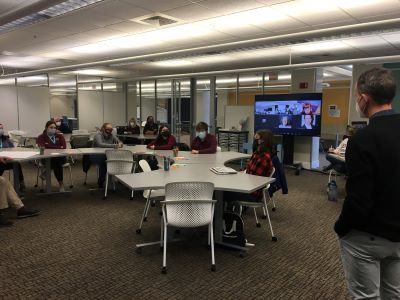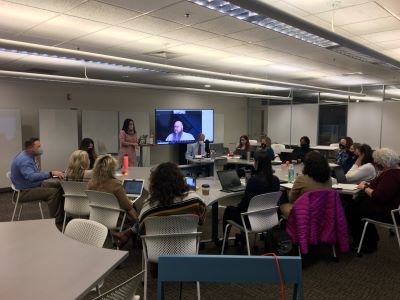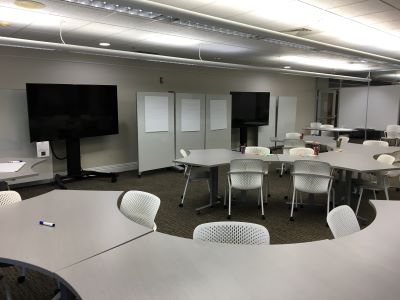How to conduct hybrid meetings
Navigation
Before you begin...
Hybrid meetings and events can commonly be broken down into 4 different delivery methods
Blended Synchronous
- Students are present both in-person and online. Lectures are often available offline for asynchronous students.
Synchronous Distributed
- Groups of students attend from different classrooms while the instructor lectures from one. The instructor is broadcast from the host classroom to the other classrooms. (E-Presence)
Remote Instructor, in-person learners
- All students are together in one classroom, while the instructor or guest-lecturer joins online via video conferencing.
Flipped Classroom
- Course content is shared asynchronously and in-person meetings discuss and complete assignments/activities around the content in an active learning classroom.
Where is the audience? Where is the presenter?
The best way to deliver a hybrid meeting is to know the needs and accessibility of your audience and presenter. How many will be attending in person? How many will be online? Will your presenter be in-person or online? Before we consider what technology to adopt, we must determine a delivery method that fits the goals, preferences, and limitations of our audience and presenter. Identify which of the hybrid meeting styles above best fit your classroom design.
-
Increased Flexibility: Hybrid meetings offer increased flexibility for attendees, regardless of their locations.
-
Enhanced Collaboration: Hybrid meetings create new opportunities for collaboration from diverse perspectives and locations.
-
Improved Learning Experiences: Hybrid meetings integrate the advantages of both in-person and online learning.
Best Practices
- Identify the location your hybrid meeting will be hosted from. E.x.: Your office, public space, library, etc.
- Test all equipment and meeting tools inside the space to ensure a smooth experience for those in attendance.
- Preview the meeting as a virtual attendee to check for flaws in connection/display.
- Allocate time early in your meeting to troubleshoot and assist participants with technical issues. Have a backup host or activity for participants to do while troubleshooting.
Establish Communication:
- Address both in-person AND virtual participants directly throughout the meeting.
- Give opportunities for both in-person and virtual participants to speak and offer input.
- Encourage participants to interact with each other, regardless of location.
- Utilize virtual whiteboard, presentations, videos, and other visual aids to enhance the meeting experience.
- Share relevant documents before and after the meeting virtually.
- If using physical documents, share relevant material with online participants before the meeting, and during.
Set Meeting Structure:
- Establish guidelines for participation. Including hand-raising or chat functions. Build more response time for online participants as connection delays can cause interruption.
- Encourage all participants to mute when not speaking to minimize background noises.
- Video participation is optional for online participants.
- Plan interactive activities that include both in-person and remote participants.
- Use breakout sessions or group activities that encourage collaboration between different locations.
- Record hybrid meetings when possible for participants who could not attend in real-time. These can also be valuable for you to review and document what a class accomplished and how meetings can be improved.
- Share the recording and any documentation shared after the meeting for participants to review.
- Allocate time for participants to ask questions.
- Utilize virtual tools (listed in resources section) to collect questions from attendees.
- Actively request feedback from participants about their experience with the hybrid format.
- Use this feedback to continuously improve future hybrid meetings.
The Set-Up
An example of our report with the First Year Think Tank can be found here. This includes our total equipment, setup time, and recommendations for the next meeting.
Below is a recommendation for a standard Blended Synchronous hybrid meeting set-up:
Total Administrators: 2-4
Hybrid Meetings require multiple administrators to operate smoothly. A minimum of two are recommended to fill the following roles:
Facilitator(s):
The Facilitators are the key speakers of the meeting. They are in charge of interacting with the audience and presenting material.
Moderator:
The Moderator plays the key role of representing the remote audience for the in-person audience. The Moderator tracks the chat room and is the physical stand in and spokesperson for the online crowd.
AV/Technician:
The AV/Technician or Audio/Visual Technician is responsible for maintaining the technology of the hybrid meeting, this includes all cameras, audio sources, displays, and monitoring the meeting room for technical difficulties or unintentionally unmuted mics/video feeds.
Testing Time: 30 Minutes - 1 Hour
Set aside plenty of time prior to the event (often days or a week before) to test technology inside the space.
Set-Up Time: 1 Hour before the event minimum.
Arrive to your location early to set up equipment and test connections. This time also allows virtual participants to interact and test audio/connections.
Equipment:
For successful hybrid meetings, you need the following as a minimum.
Video Capture:
Your Video Capture is your webcam/Owl/Conference Camera that directly gives the participants a visual to your meeting.
Audio:
Your audio is the most important piece of your hybrid meeting. Without proper audio capture/output participants will have a very poor experience. Your audio capture can include Owl/USB Microphone/Catchbox/Podium or room mics. It is highly recommended that you do NOT use your laptop microphone for audio capture when you are a key speaker. The audio quality will be poor in addition to picking up every sound of you typing on the keyboard resulting in a very distracting experience.
Your audio output (what in-person participants hear) is crucial to relaying any comments or discussions from your online audience. Your output devices could include display speakers/Owl/room speakers/USB Speakers. It is highly recommended that you do not rely on laptop speakers to output sound to a room.
Display:
To properly input online participants inside the room, external displays are recommended. This display or multiple displays, allow your in-person attendees to see and hear your remote participants while also having access to visual aids. In addition, it is recommended that you assign a display specifically for your facilitators to see your remote participants as well as any media that they will display.
Below are some visual examples of how the FCT&L conducts hybrid meetings.
--
Resources
Recommended Tools for Hybrid Meetings
Video Conferencing Platforms:
- Zoom
- Microsoft Teams
- Google Meets.
- Google Suite (Docs, Sheets, Presentations, etc.)
- Microsoft 365
- Google Jamboard
- Miro
- Microsoft Whiteboard
- Mentimeter
- Poll Everywhere
- Google Forms
Equipment:
- The Owl Labs conferencing camera is a 360 degree camera designed for handling roundtable discussions. This portable all-in-one device is perfect for handling on the go meetings with simple set-up and positive results. The Owl integrates perfectly with Zoom and can enhance your meeting by utilizing its auto tracking camera to actively highlight speakers. You can check out an Owl at the EKU Library and from the EKU IT Service Desk.
- When presenting from your laptop or personal computer, Ring Lights can be used to greatly enhance your video quality and give yourself a more professional appearance.
- The Catchbox is an interactive throwable microphone that can be used as a fun way to engage your audience and gather clear audio to your Zoom meeting. The Catchbox is accompanied by a clip microphone that the facilitator can wear so that both they and the audience can be heard.
One Button Studio:
The One Button Studio (OBS) is an all-in-one recording studio that can also be used for hybrid meetings. The facility is equipped with a professional 4k camera, audio capture, lighting, and greenscreen to enhance your virtual meetings/recordings. This studio is free for faculty to use and can be reserved by visiting here.



